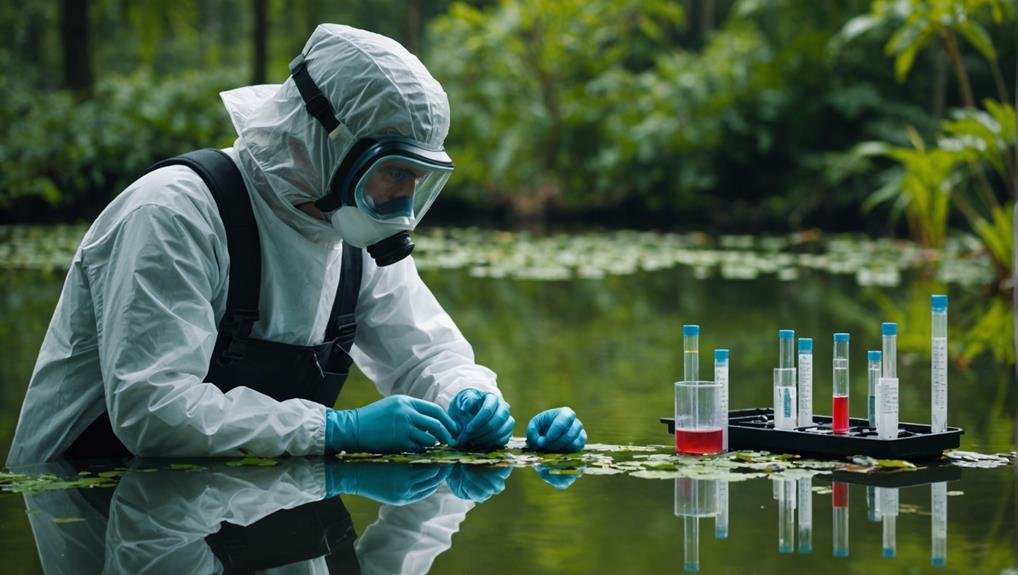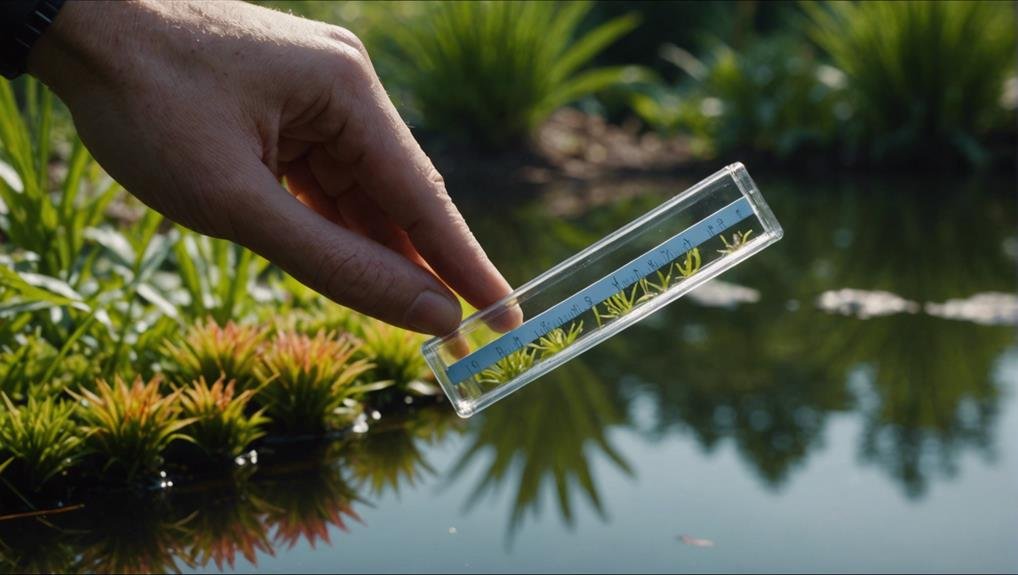Regular testing of pond water is crucial to identify harmful contaminants and ensure a healthy aquatic environment. Common pollutants to watch out for include bacteria, pesticides, excessive nutrients, and heavy metals. Utilizing test kits to measure pH, ammonia, nitrate, and dissolved oxygen levels is essential.
It is recommended to maintain ammonia levels between 0-0.5 ppm and keep nitrate levels below 0.3 ppm. Monitoring carbonate hardness (KH) and general hardness (GH) aids in achieving a balanced ecosystem. Maintaining a pH range of 6.5 to 9.0 is vital for the overall health of aquatic life in the pond.
By understanding and managing these factors effectively, we can promote optimal water quality in our pond.
Importance of Water Testing
Water testing plays a crucial role in safeguarding the health of pond ecosystems by detecting harmful contaminants. Regular testing helps us pinpoint toxins and pollutants early on, ensuring the well-being of aquatic life.
By monitoring bacteria, nitrates, ammonia, and phosphorus levels, we can prevent serious issues such as algae blooms and fish fatalities.
The data obtained from water testing is invaluable in implementing effective remediation strategies to uphold a balanced ecosystem. Without consistent testing, harmful contaminants can accumulate, leading to toxic conditions that pose risks to fish, plants, and other aquatic organisms.
Identifying the levels of pollutants in pond water is the initial step in taking necessary actions. For instance, high phosphorus levels signal a potential risk of algae blooms, which can deplete oxygen levels and harm fish populations. Similarly, detecting ammonia spikes early can help prevent fish fatalities and other critical problems.
In essence, water testing serves as a proactive measure to maintain pond health and prevent ecosystem disruptions. Regular monitoring and prompt actions based on test results are vital for sustaining a thriving aquatic environment.
Common Pond Contaminants
Pond water can easily become contaminated by pollutants like bacteria, pesticides, excessive nutrients, and heavy metals, which can harm the ecosystem. Bacteria, especially E. coli, can enter ponds through animal waste, highlighting the need to address runoff sources.
Runoff from farms or urban areas can introduce pesticides, chemicals used to control pests, posing a threat to aquatic life.
Excessive nutrients such as nitrogen and phosphorus, often from fertilizers, can cause algae overgrowth. Algae blooms reduce oxygen levels in the water, endangering fish and other aquatic creatures. Monitoring nutrient levels is crucial to prevent these harmful blooms and maintain a balanced pond environment.
Heavy metals like copper, iron, and manganese can also contaminate pond water, typically from industrial runoff or natural mineral deposits. High concentrations of these metals can be toxic to aquatic life and impact water quality significantly.
Regular monitoring for contaminants like ammonia, nitrate, and total dissolved solids is essential for pond health. Understanding these common pollutants enables us to take proactive steps to safeguard our ponds and support a thriving aquatic ecosystem.
Selecting Test Kits

When selecting test kits for pond water, it's essential to consider the specific contaminants you need to monitor. Testing water quality is crucial for identifying pond pollutants and maintaining a healthy ecosystem. These kits typically measure important parameters such as pH, ammonia, nitrate levels, and dissolved oxygen. These tests play a key role in preserving the overall well-being of the pond.
For pH testing, a reliable kit can reveal if the water is too acidic or alkaline. Detecting high levels of ammonia is vital as it can harm aquatic life. Monitoring nitrate levels is also significant, as they can indicate nutrient pollution that may lead to algae overgrowth. Additionally, maintaining proper dissolved oxygen levels is critical for the survival of fish and other aquatic organisms.
Some test kits may also include nutrient testing for elements like phosphorus and total dissolved solids (TDS), which can impact water quality.
Regularly using these kits allows for the early identification of common pollutants and potential issues. This proactive approach helps in sustaining a balanced pond ecosystem, ensuring a safe and healthy environment for all pond inhabitants.
Testing for Ammonia
Testing the ammonia levels in our pond is crucial to ensuring the safety of our aquatic residents. Ammonia, a harmful compound, can pose a serious threat to fish and other organisms living in the pond. The presence of ammonia in the water is often a result of fish waste, decaying organic matter, and excess fish food.
Regular testing allows us to monitor the levels of ammonia and ensure they stay within the optimal range of 0-0.5 parts per million (ppm). If the levels go beyond this range, it can put the health of our fish and other creatures at risk. High ammonia levels can lead to stress, sickness, and even death among the aquatic life in the pond.
To test for ammonia, it's important to use reliable test kits specifically designed for pond water. These kits typically involve collecting a water sample and adding specific reagents that change color based on the concentration of ammonia. By comparing the resulting color to a chart, we can determine the ammonia levels present in the water.
Monitoring and maintaining the ideal levels of ammonia is essential to prevent the accumulation of harmful substances. By identifying sources of excess ammonia, such as overfeeding fish or allowing organic matter to decay unchecked, we can take appropriate measures to protect the health and balance of our pond ecosystem.
Measuring Nitrate Levels

Maintaining a healthy pond ecosystem necessitates monitoring ammonia and nitrate levels. Nitrate levels can be accurately assessed using test kits or lab analysis, with the ideal level being below 0.3 ppm to prevent nutrient pollution that fuels excessive plant and algae growth.
Elevated nitrate levels can disrupt the pond ecosystem by promoting algae growth, depleting oxygen, and endangering aquatic life. Regular monitoring is essential to detect pollution sources like fertilizers or animal waste. Monitoring nitrate levels helps preserve water quality and prevents harmful algae blooms.
Various methods can be employed to measure nitrate levels. Test kits provide quick and easy results but are less precise than lab analysis. Laboratory analysis offers high accuracy but is time-consuming and costly. Nitrate sensors enable continuous monitoring but involve a higher initial investment.
Visual inspection is cost-free but unreliable and imprecise. Digital testers are portable and user-friendly but require calibration. By selecting the most suitable method for monitoring nitrate levels, pond owners can safeguard their aquatic environment effectively.
Monitoring Nitrite Levels
Maintaining zero nitrite levels in pond water is crucial for the health of aquatic life. High nitrite levels, especially above 1 ppm, can be extremely harmful to fish and other organisms. Nitrite contamination often stems from decaying organic matter, overfeeding fish, or inadequate filtration systems. Therefore, it's vital to regularly monitor nitrite levels to ensure our pond water remains free of harmful contaminants.
Water testing kits are effective tools for accurately detecting nitrite levels. These kits are user-friendly, providing quick results that enable us to pinpoint any potential issues early on. By consistently testing the water, we can promptly address any changes in nitrite levels that may arise.
In the event of high nitrite levels, there are several strategies we can employ to lower them. Conducting water changes is a simple yet effective method to dilute nitrites. Improving aeration can also enhance water quality by boosting oxygen levels, which support beneficial bacteria that convert nitrites into less harmful substances.
Furthermore, reducing nitrogen sources such as avoiding overfeeding fish and ensuring proper filtration can help prevent nitrite buildup. By staying vigilant and taking proactive measures, we can create a healthy environment for our pond's aquatic inhabitants.
Checking KH Levels

Maintaining the right levels of KH in our pond water is essential for a balanced pH and to support the health of the ecosystem. KH, also known as carbonate hardness, acts as a buffer to prevent sudden pH changes. It's best to keep KH levels between 5-10 ppm to ensure a thriving environment for plants and aquatic life.
When KH levels are low, the water can become too acidic, impacting plant growth and harming fish and other organisms. To address this, we can raise KH levels by adding crushed coral or epoxy rocks to the pond. These materials gradually release calcium carbonate, boosting KH levels and stabilizing the water.
On the other hand, if KH levels are too high, introducing plants like Anacharis or Water Lettuce can help. These plants absorb carbonates, reducing the water's buffering capacity and maintaining stable KH levels.
Regularly testing and adjusting KH levels is crucial for a stable pH and overall pond health. By doing so, we create a balanced ecosystem where biological processes can flourish, resulting in a vibrant and thriving pond environment.
Evaluating GH Levels
Let's dive into the evaluation of GH levels to ensure that our pond's water quality is conducive to a thriving ecosystem. GH levels, which measure the calcium and magnesium content in pond water, play a significant role in maintaining a balanced pond environment. It's crucial to keep these levels within the essential range of 5-15 ppm.
To effectively manage GH levels, follow these four key steps:
- Begin by measuring the GH levels using a test kit. This initial step provides important information about the calcium and magnesium concentrations in the pond water, serving as a baseline for further actions.
- If the GH levels are below 5 ppm, address this issue by adding limestone or calcium carbonate. These substances can gradually raise the GH levels, ensuring that the pond water reaches the optimal range for a healthy ecosystem.
- In cases where GH levels exceed 15 ppm, it's necessary to manage this high concentration. Consider adjusting the pH balance using appropriate chemicals or implementing mechanical filters such as air stones to reduce the excess calcium and magnesium in the water.
- Incorporating plants like Anubias or Java ferns into the pond can also help regulate high GH levels naturally. These plants contribute to maintaining a balanced ecosystem by assisting in the reduction of excessive calcium and magnesium.
Assessing Ph Balance

Maintaining the pH levels in pond water within the optimal range of 6.5 to 9.0 is crucial for ensuring a thriving ecosystem. Monitoring the pH levels regularly is essential to uphold water quality and support the health of aquatic life.
By testing the pH levels consistently, we can pinpoint any harmful imbalances that may impact the well-being of the pond inhabitants. When low pH levels are detected, adjustments can be made by adding substances like baking soda or limestone to increase alkalinity. On the other hand, high pH levels can be lowered by introducing acidic elements such as vinegar or peat moss to restore balance to the water chemistry.
Proper pH balance is key to sustaining the overall health of pond ecosystems, as imbalances can stress aquatic life and make them more vulnerable to diseases, hindering their ability to thrive. Through regular pH testing and necessary corrections, we ensure that our ponds remain vibrant and healthy environments.
Interpreting Test Results
Maintaining proper pH balance in a pond is crucial, but it's equally important to accurately interpret test results to identify harmful contaminants in the water. Understanding these results is key to preserving the quality of pond water.
When testing for E. coli bacteria, levels exceeding 126 colonies per 100 mL indicate contamination from sources like septic systems and wildlife waste. High levels of E. coli can pose significant health risks, underscoring the importance of addressing the issue promptly.
Elevated levels of nitrate-nitrogen and total phosphorus in pond water may point to pollution from fertilizers or manures, leading to excessive plant and algae growth. This overgrowth can result in oxygen depletion, jeopardizing the well-being of aquatic life in the pond.
Monitoring total dissolved solids (TDS) is essential, with levels surpassing 1,000 mg/L potentially signaling water quality concerns. Elevated TDS levels can impact the taste, clarity, and overall health of the pond ecosystem, emphasizing the need for proactive measures to address any issues.
Maintaining ammonia levels below 0.5 ppm is critical, as high concentrations can be toxic to aquatic life. To mitigate high ammonia levels, consider reducing nitrogen sources and introducing beneficial bacteria to help lower the levels effectively.
Conclusion
Testing pond water regularly is crucial to ensuring a healthy environment for aquatic life. Using specific test kits to check for contaminants like ammonia, nitrate, KH, GH, and pH is essential for maintaining water quality.
Understanding these results allows us to address any issues promptly, keeping our ponds safe and thriving. It's important to be proactive in monitoring water quality to prevent any negative impacts on the pond ecosystem.
Let's stay vigilant in caring for our ponds to avoid any undesirable outcomes.

